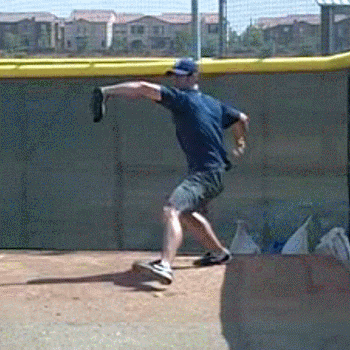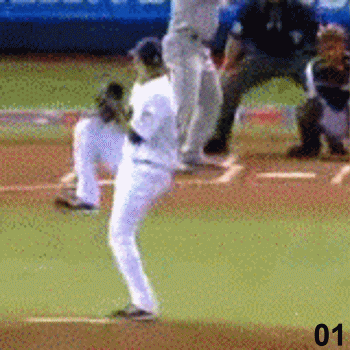 Early Torso Rotation (ETR) is a particularly severe type of Timing problem that seems particularly likely to cause shoulder problems -- and often Labrum problems -- not just elbow problems.
Early Torso Rotation (ETR) is a particularly severe type of Timing problem that seems particularly likely to cause shoulder problems -- and often Labrum problems -- not just elbow problems.
Pitchers who exhibit(ed) Early Torso Rotation include...
I also saw signs of ETR in Chris Carpenter's pitching mechanics, which likely explains why they were deceptively bad.
Two Types of Timing Problems
There are two general types of timing problems
Limited External Rotation at Front Foot Plant
Generally speaking, a pitcher's shoulders will start rotating at Foot Plant, which is why I use it when it comes to evaluating pitchers. In the worst case Timing problem, which I call Flat Arm Syndrome, the pitcher's arm isn't up and ready when their front foot plants and their torso and shoulders start rotating.
It's flat and late.
Early Torso Rotation
In some -- relatively rare, but perhaps increasing -- cases, pitchers' torsos and shoulders will start rotating before Foot Plant.
In the clips below, ignore Foot Plant. Simply focus on the position of the arm -- whether it's up at 90 degrees of external rotation or flat and at 0 degrees of external rotation -- when the shoulders start rotating and the pitcher's elbow starts coming around. In each case, the pitcher's shoulders -- and thus their torso -- start rotating early; before foot plant.

Mark Prior 2010

Johan Santana with the Twins

Stephen Strasburg
Early Torso Rotation is particularly hard to identify because pitchers who exhibit it will often display in still photos what looks like good Timing. However, you can see the problem if you study their mechanics from the center field view.
ETR and the Douoguih Study
While Douoguih's Early Cocking Phase Mechanics study found a statistically significant difference, that difference was smaller than I expected, and small enough to make people wonder if it is really that big of a deal.
I believe one reason why the results of the Douoguih study were only slightly significant was because they inadvertently set out to study the rarest, but admittedly worst, form of Timing problem. I believe the difference would have been more significant had they studied the more common form of a Timing problem, one where the pitching arm isn't at 90 degrees of external rotation at Foot Plant.